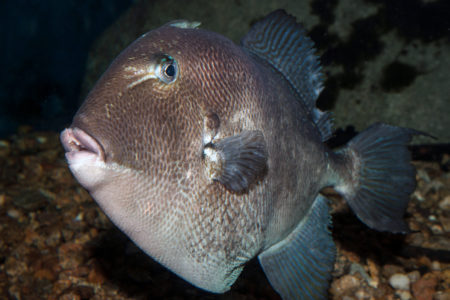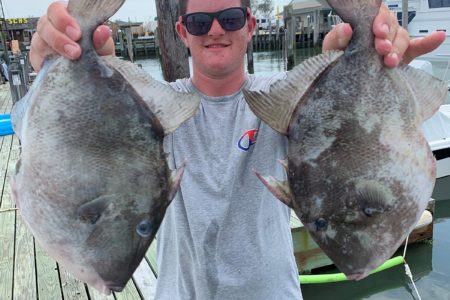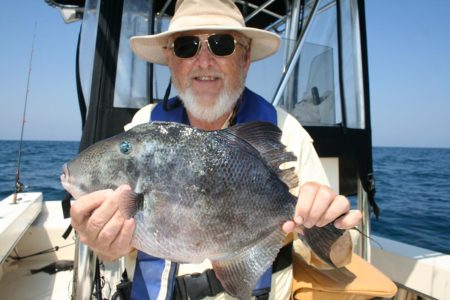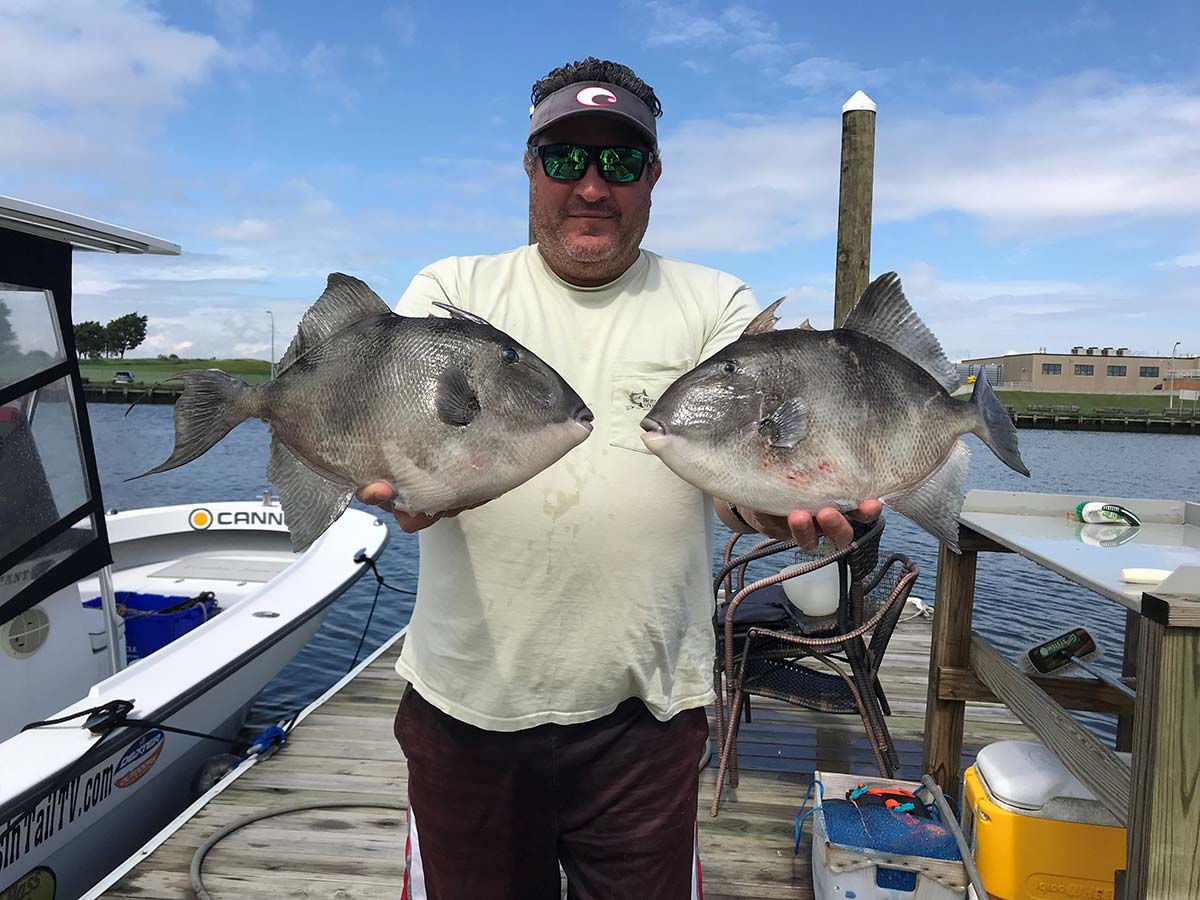
They’re not only fun to catch but a delicacy on the plate.
I recall catching my first triggerfish while fishing for blackfish along the west end jetty of Fire Island Inlet known as the Sore Thumb back in 1978. Man I recall how great the fishing was from this strip of rock jetty until 1985 when Hurricane Gloria put a severe hurting on this gem. The late, great Fisherman Senior Editor Fred Golofaro along with great surfcasters like John Fritz and John (Zorba) the Greek spent many nights in September and October tossing live snappers and often nailing weakfish over 13 pounds, along with fluke to 11 pounds and stripers way back then under 10 pounds.
At the age of 17, my nights were limited due to school studies. However the nights I was able to escape to the Thumb, I would watch this trio plus plenty of other casters work their magic until the Sore Thumb was swept away to the center of the inlet. As for the triggerfish, I didn’t see them again until the mid-90s from the Moriches Reef and there were plenty of them at that. Today triggerfish can be thick as fleas at any rock pile and among the buoy chains wherever there is clean ocean water and on all the ocean artificial reefs. If you are unfamiliar with triggerfish, stay with me as they’re not only fun to catch but a delicacy on the plate.
Trigger & Triggering
Although there are more than 40 species of triggerfish that are scattered throughout the world, the grey triggerfish is the prominent species that cram into most nook or cranny lairs along the Northeast during the summer and early fall seasons. Triggerfish get their name from spines on their dorsal fin that can be used as a predator defense mechanism. The first set of spines are large, and when under attack the fins become erect — it remains so until the fish deflexes the smaller second spine, “triggering” the first. When a triggerfish is threatened it will dive into a tight crevice and anchor itself into place by locking its erect spine. Species such as sharks prey upon adult gray triggerfish, while tuna, bullhead dolphin, marlin, sailfish and small sharks prey upon juvenile gray triggerfish.
“Hard” To Come By
Triggerfish primarily eat benthic invertebrates including crabs, sea urchins, shrimp, sand dollars, lobsters and mollusks. They have a small mouth with a strong jaw and specialized teeth used to crush and chisel holes in their hard-shelled prey. These bottom dwellers dig out prey, such as crabs and worms, by flapping away debris with their fins and sandblasting with water squirted from their mouths. They also employ their very tough teeth and jaws to take on sea urchins, flipping them over to get at their bellies, which are armed with fewer spines. Triggerfish wreak such havoc on less fortunate reef dwellers that smaller fish often follow them to feast on their leftovers. Juvenile gray triggerfish feed on hydroids, barnacles and polychaetas.
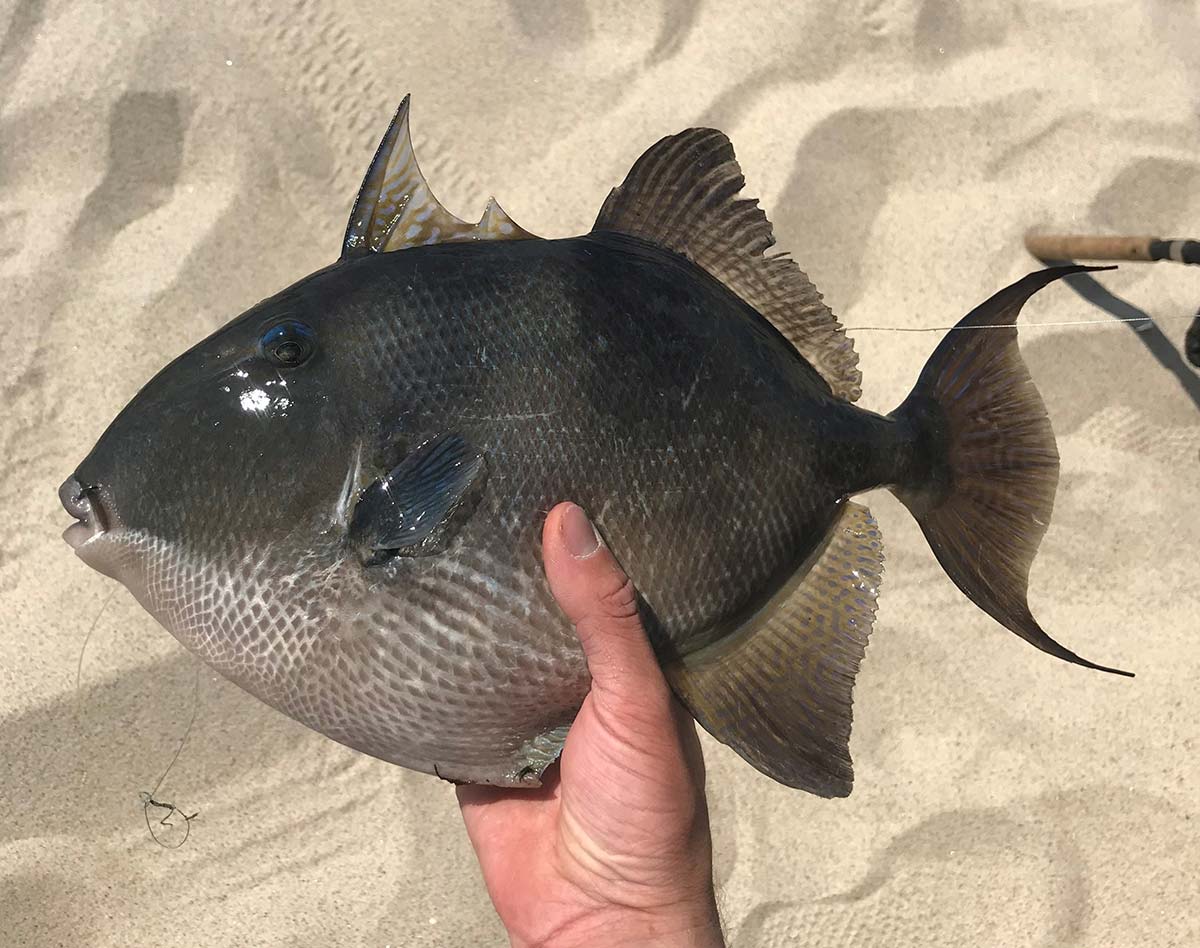
Where To Locate
Triggerfish hunting is just as simple inside a sheltered bay as is finding them out in the big pond. Inside the bays, look for lively bottom structure such as rocky ledges, rock piles, broken docks or anything with some sort of obstruction. Green Can and Red Nun Buoys and their buoy chains are great places to find triggerfish, especially at buoys near ocean inlets during a flood tide while the water is at its cleanest.
| IDENTIFYING GRAY TRIGGERFISH |
| As for identifying gray triggerfish, adults are primarily olive-gray, have blue spots and lines on the upper body and dorsal fin and the upper rims of their eyes are blue. Along the tops and bottoms of their bodies they sprout large fins. The top fin (dorsal) and bottom fin (anal) are quite large and provide most of the fish’s motion. When they must swim quickly, they use their tail fins. These beautiful fish are intriguing creatures, which have a number of traits and behaviors to help them survive in their ocean environment. |
As for the ocean fish, you can start right at the local jetties during slack tide, then as you head for the clean blue, artificial reefs, clam beds and hard bottoms offer the best opportunity for triggerfish. Most divers have learned to locate triggerfish by studying good sonar with eyeball observation. Many fishermen/divers physically go down and observe the bottom structure and seeing how different species relate to the structure, which gives clues as to what you are seeing on the bottom recorder as you pass over a spot. Boat position is critical and proper anchoring is the key. If you’re off the spot by 40 or 50 feet, you may not catch triggerfish, even though they may be plentiful just a few yards away.
Tackling Triggers
Similar to blackfish, triggerfish have relatively stout teeth designed for crushing. A standard slip sinker, or inline sinker rigs has 20-pound main line and 1 to 2-ounces of lead. A 30-pound fluorocarbon leader rounds out this rig. A more effective rig, particularly for quick jawed bait stealers is the Knocker Rig which is popular along the southern states. This rig puts a slip sinker on the leader so it slides down and “knocks” against the hook for a streamlined presentation. When a triggerfish takes the bait, the leader slips back through the weight without spooking the fish with immediate resistance. Depending on water depth, knockers with 1 to 2-ounce weights sliding over 1/0 or 2/0 super sharp Gamakatsu Octopus hooks will do the job. When a triggerfish gets a solid grip on a bait, just let the fish pull the rod tip down and continue the pressure with steady reeling. Don’t jerk the rod, just respond by steady reeling. Lastly, the most commonly employed rig along the Northeast is a hi-lo rig, which is a pair of hooks on Dropper Loops with a sinker rigged at the end of the tag. The setup keeps the pair of baits about a foot or so off the bottom.
Speaking of rods and reels, when fishing on the reefs or any area of structure with sticky bottom for that fact, your best results will come from rods with fast taper tips for sensitivity, and the powerful butt tapers for the lift needed to haul any outsize species from the wonderland of the sea. I match the rods with a conventional reel with the power and speed at a 6 to 1 ratio to get the fish off the structure before they have a chance to realize they have been had.
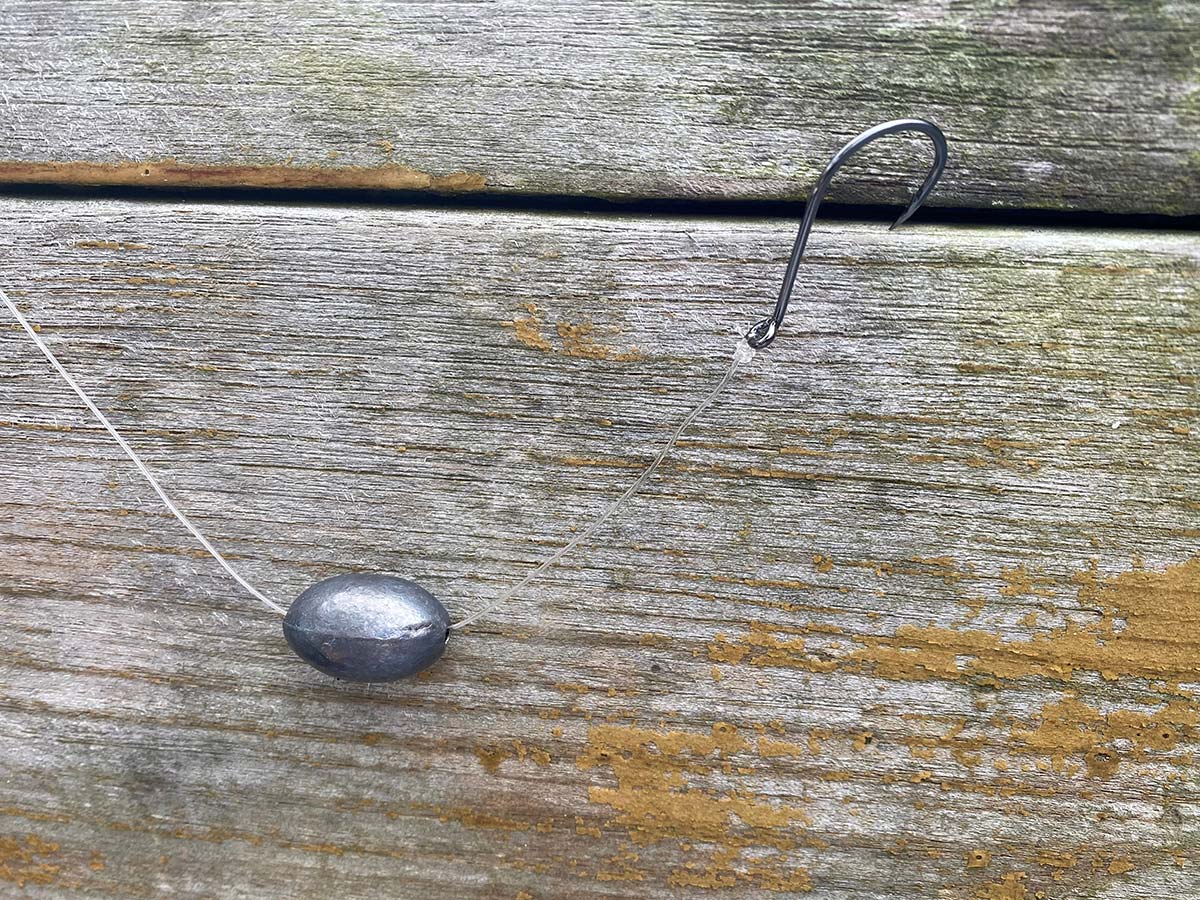
Feeding Triggers Made Easy
It’s true that triggerfish depend on benthic invertebrates to live happily in the sea. However as omnivorous feeders, pleasing their palate is as easy as whatever bait being employed at the time. Therefore it doesn’t matter if Asian, fiddler or green crabs is the bait of choice or something as simple as a strip of squid or clam, rest assured that all these baits will get the attention of a hungry triggerfish.
Chum And They Will Come
Whether fishing the buoy chains in the bay or fishing on one of the several artificial reefs or wrecks out in the ocean, employing chum will undoubtedly increase the action immensely. In fact, chumming correctly can create fish insanity since many times aboard my boat, while reeling in a single or doubleheader of triggerfish, 30 or 40 other triggers came to the surface and were more than willing to take whatever bait or chum spat we had to offer.
When fishing along the buoy’s and their chains, it is best to anchor approximately 100 feet up tide from the designated structure and hang a chum bag over the side and allow the chum to flow into the current and it will work its magic. Triggerfish are not shy and will often come to the surface for a free meal. The variety of rigs described will all work well along the chains.
In the ocean where most fishing will be done in relatively deep-water, sending a chum pot filled with a log of clam or bunker chum right smack on the bottom will produce an aquarium of species and a hi-lo rig will keep the rods bent for much of a tide.
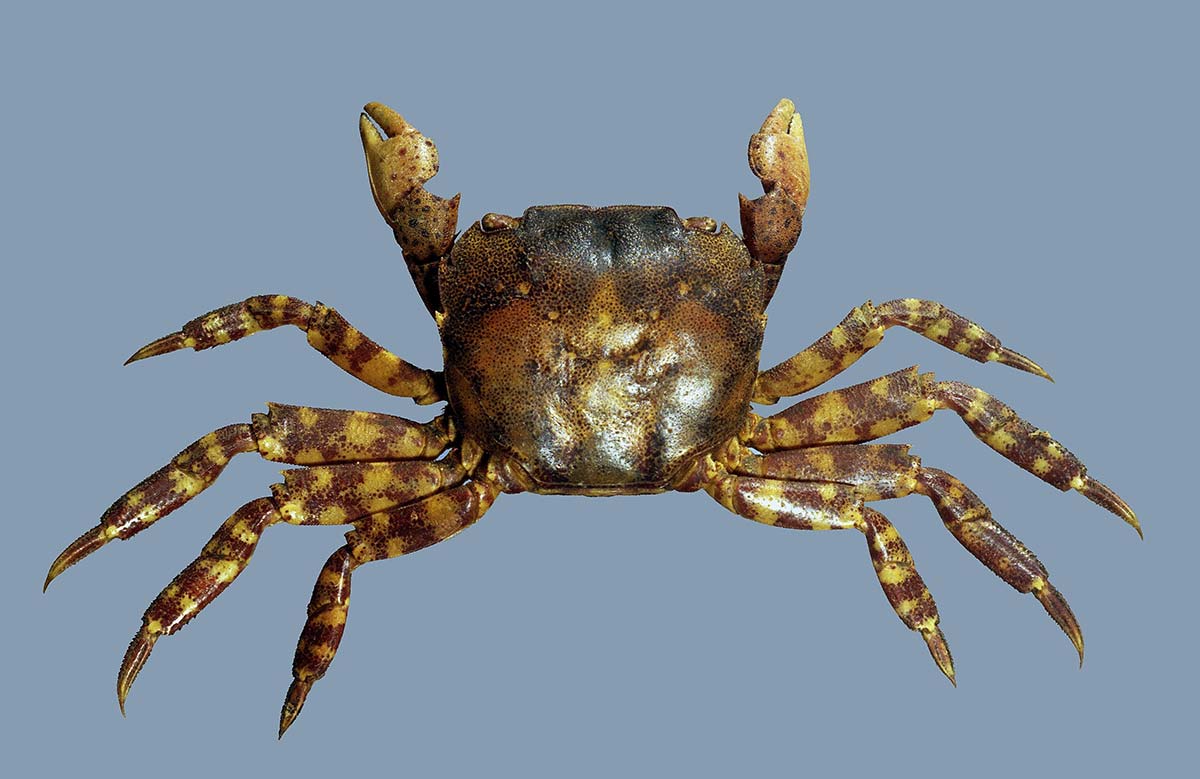
Fillet, Dress And Enjoy
Triggerfish belong to a group of species collectively known as leatherjackets for their extremely tough skin and without a distinct plan, accessing the prized meat can seem like trying to crack a locked safe. The road to successfully filleting your days catch begins with a high quality fillet knife sharpened to perfection. Puncture the fish’s skin in the soft area just behind the gills, cut upward to the dorsal fin and then start working the blade down the backbone and around the rib cage. Repeat the process on either side. Trying to find an entry point on the back, or trying to cut from the tail forward offers a lesson in futility. The good part about the trigger’s tough skin is that removing the meat is like scraping butter off a slice of toast.
| HANDLE WITH CAUTION |
| Triggerfish are infamous for their nasty attitude and this behavior is especially evident around nests, where intruders such as other fish or human divers are likely to be attacked or bitten. However, they don’t attack without reason. Most angry triggerfish are actually protecting their nests from perceived predators. Once caught and out of the water, triggerfish would love nothing more than to rip the flesh right off human fingers. This species sees just as well out of water as in it. Therefore handle these fish with caution, otherwise they will leave a lasting impression by using their powerful jaws. |
An alternative to filleting would be to cut from the anal vent forward and remove all the innards, along with the eyes and gills. Stuff the cleaned-out gastric cavity with shrimp/scallop dressing or pieces of your favorite citrus. Score the flanks and drench them with melted butter and citrus juice. Place the fish in a greased dish and bake at 350 degrees for 20 to 30 minutes.
If you enjoy the flavor of the fishes of the Caribbean and South America, you’re going to love the mild firm white meat of the triggerfish, which will again provide great action and table fare in 2023. Keep in mind that there are no regulations for gray triggerfish along the Northeast as of now, however, that can change at the drop of a dime if the Feds feel the trigger fishery becomes threatened of overfishing. Let’s all practice self-restraint, taking a fish or two for the table while releasing the remainder for another day.
